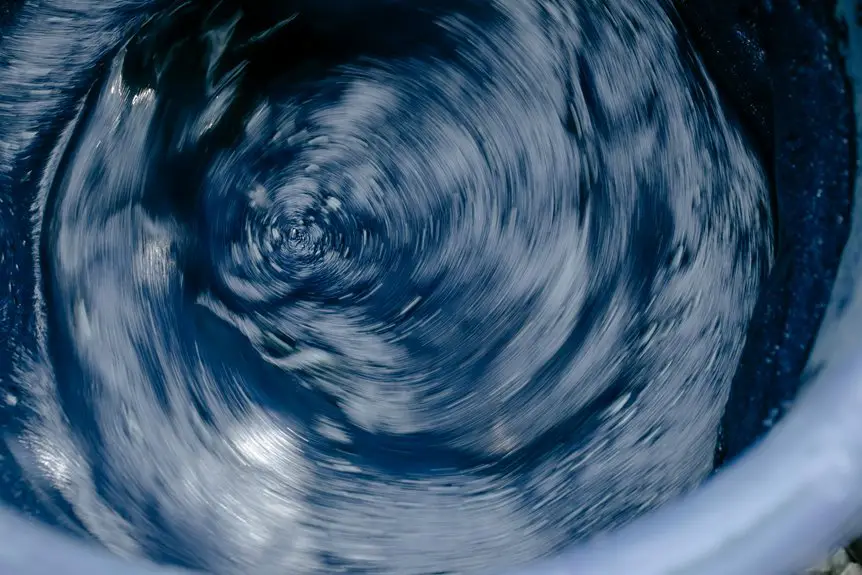To prevent tie-dye from bleeding, always rinse with cold water and avoid warm or hot temperatures that loosen dye. Use gloves and gently blot excess dye before soaking the fabric in cold water until it runs clear. Wash with a mild, color-safe detergent on a gentle cycle or by hand, and air dry out of direct sunlight to preserve vibrancy. Turning the garment inside out also helps protect colors. Keep following these tips to maintain bright, lasting designs.
Table of Contents
Key Takeaways
- Rinse tie-dye in cold water repeatedly until the runoff is nearly clear to lock in colors and reduce bleeding.
- Use mild, color-safe detergent and avoid bleach when washing tie-dye to preserve dye stability.
- Hand wash or use a gentle machine cycle with the garment turned inside out to minimize friction and color loss.
- Incorporate vinegar and salt during washing as natural fixatives to enhance color retention and prevent bleeding.
- Air dry tie-dye away from direct sunlight or use a low heat dryer setting to avoid fading and over-drying.
Understanding Why Tie-Dye Colors Bleed
Although tie-dye looks vibrant and fun, its colors can bleed because the dye hasn’t fully set into the fabric yet.
When you apply dye, especially on cotton or other natural fibers, the pigments need time to bond with the fibers. If you rinse or wash the garment too soon, the dye particles haven’t anchored properly and can wash away, causing bleeding.
Heat and chemical fixatives help set the dye, but without those, the colors remain unstable. Also, certain dyes are more prone to bleeding, especially if you use excess dye or don’t let the fabric rest long enough.
Understanding this helps you avoid common mistakes and guarantees your tie-dye stays bright and clear without colors running into each other.
Essential Supplies for Rinsing and Washing Tie-Dye
To properly rinse and wash your tie-dye, you’ll need some key cleaning materials like mild detergent and cold water.
Don’t forget protective gear such as gloves to keep your hands safe from dye stains.
Having these supplies ready will make the process smoother and protect both your skin and clothes.
Necessary Cleaning Materials
When you start rinsing and washing your tie-dye, having the right supplies makes the process smoother and protects your vibrant colors.
Gather a large basin or sink for soaking, plus a clean plastic or stainless steel tub for rinsing. Use cold water to prevent color bleeding. You’ll need a mild, color-safe detergent designed for delicate fabrics—avoid bleach or harsh chemicals.
A mesh laundry bag comes in handy if you plan to machine wash your piece, reducing friction. Also, keep a few clean towels nearby to blot excess water gently.
Finally, a soft brush or cloth helps remove any residual dye during rinsing without damaging the fabric. With these materials on hand, you’ll efficiently clean your tie-dye while preserving its bright patterns.
Protective Gear Essentials
Having the right cleaning materials is just one part of keeping your tie-dye looking fresh. You also need protective gear to avoid stains and skin irritation during rinsing and washing.
First, grab a pair of rubber gloves to shield your hands from harsh dyes and chemicals. An apron or old clothes will protect your outfit from accidental splashes.
Consider wearing goggles if you’re working with strong dyes or bleach to keep your eyes safe. A face mask can prevent inhaling any fumes, especially in poorly ventilated areas.
Finally, have a dedicated workspace with newspapers or plastic sheets to catch drips and avoid staining surfaces.
Using this essential gear keeps both you and your environment safe while preserving your vibrant tie-dye colors.
How to Prepare Your Tie-Dye for the First Rinse
Before you start rinsing your tie-dye, make certain the dye has fully set to avoid bleeding colors. Typically, this means letting your fabric sit wrapped in plastic for at least 6 to 24 hours.
Once the dye has set, it’s time to prepare for rinsing. Begin by removing any rubber bands or ties gently to prevent fabric damage.
Next, hold your garment over a sink or bucket to catch excess dye runoff. Use cold water at first to help lock in colors and reduce bleeding.
Avoid soaking the fabric immediately; instead, rinse it under a gentle stream to flush out the loose dye. Preparing your tie-dye this way guarantees vibrant colors and minimizes unwanted color mixing during the wash process.
Step-by-Step Guide to Rinsing Tie-Dye Without Color Run
Before you start rinsing, make sure your tie-dye is ready by removing any excess dye carefully.
Use cold water to rinse, as it helps prevent the colors from bleeding.
Finally, wash your garment gently to keep the vibrant patterns intact.
Pre-rinse Preparation
Although rinsing tie-dye might seem straightforward, taking a few careful preparatory steps can prevent color bleeding and preserve your design.
Before you start rinsing, it’s essential to set up properly.
- Wear gloves to protect your hands from staining and harsh chemicals.
- Prepare a clean sink or basin with enough space for your garment to move freely, preventing uneven rinsing.
- Remove excess dye by gently blotting the fabric with a paper towel or cloth—don’t rub, as this may spread colors.
- Separate your tie-dye from other clothes to avoid accidental dye transfer during rinsing and washing.
Cold Water Rinse
Start by filling your basin or sink with cold water—this temperature helps lock in the vibrant colors and prevents bleeding.
Submerge your tie-dye garment fully, ensuring it’s covered by at least a few inches of water. Gently swish the fabric around to loosen excess dye without causing agitation that might spread colors. Let it soak for about 5 to 10 minutes.
After soaking, drain the water and refill with fresh cold water. Repeat the gentle swishing and soaking process until the water runs almost clear, signaling minimal dye loss. Avoid using warm or hot water, as it can cause colors to bleed.
Once the rinse is complete, carefully lift your garment out without wringing, preparing it for the next washing step.
Gentle Washing Techniques
When you’re ready to wash your tie-dye garment, choosing gentle techniques helps preserve its vibrant colors and prevents bleeding. Here’s how to do it right:
- Use cold water: Always wash in cold water to keep colors from running.
- Select a mild detergent: Choose a gentle, color-safe detergent free of bleach or harsh chemicals.
- Hand wash or use a delicate cycle: If using a machine, set it to the delicate or gentle cycle to reduce agitation.
- Avoid soaking too long: Rinse quickly and don’t leave your garment soaking, as prolonged exposure can cause colors to bleed.
The Role of Cold Water in Preserving Tie-Dye Colors
Since cold water slows down the dye’s ability to bleed, you’ll want to use it when rinsing and washing your tie-dye creations.
Cold water helps keep the dye particles locked into the fabric fibers, reducing the chance that colors will run or fade. When you rinse your garment immediately after dyeing, use cold water to gently remove excess dye without disturbing the set colors.
Later, washing your tie-dye in cold water prevents heat from loosening the dye bonds, which can cause bleeding. Avoid warm or hot water, as it can break down the dye’s hold on the fabric.
Using Vinegar and Salt to Set Tie-Dye Colors
Although cold water plays an essential role in preserving your tie-dye colors, incorporating vinegar and salt can further enhance color retention.
These natural fixatives help lock in dye molecules, reducing bleeding during rinsing. Here’s how you can use them effectively:
Natural fixatives lock in dye molecules, minimizing bleeding and preserving vibrant tie-dye colors during rinsing.
- Soak your freshly dyed fabric in a solution of 1 cup white vinegar and 1 tablespoon salt mixed with cold water.
- Let it sit for about 30 minutes to an hour, allowing the vinegar and salt to set the dye.
- Gently squeeze out excess liquid without wringing to avoid distorting the design.
- Rinse the fabric in cold water until it runs mostly clear, then air dry.
This simple step strengthens your colors, keeping your tie-dye vibrant longer.
Best Washing Practices for Tie-Dye Garments
When washing your tie-dye garments, start with a cold water rinse to help lock in the colors.
Use a gentle detergent that won’t strip the dye or damage the fabric.
These simple steps will keep your vibrant designs looking fresh longer.
Cold Water Rinse
Rinsing your tie-dye garment in cold water is one of the most important steps to preserve its vibrant colors. Cold water helps prevent the dyes from bleeding and fading, keeping your design sharp and bright.
When you rinse, follow these steps to get the best results:
- Turn your garment inside out to protect the outer surface.
- Rinse under cold running water until the water runs mostly clear.
- Gently squeeze out excess water without wringing to avoid stretching.
- Repeat the rinse if colors still bleed to minimize future fading.
Gentle Detergent Use
A gentle detergent plays an essential role in maintaining your tie-dye garment’s vibrant colors and soft texture. You want to avoid harsh chemicals that can strip dye or cause bleeding. Choose detergents labeled “color-safe” or “for delicate fabrics” to protect those bright patterns. Use only a small amount—too much detergent can leave residue and dull colors. Always opt for liquid detergent as powders may not dissolve fully, risking stains or damage.
| Detergent Type | Suitable Fabrics | Benefits |
|---|---|---|
| Liquid | Cotton, blends | Dissolves easily, gentle on dyes |
| Color-safe | All tie-dye | Prevents color fading and bleeding |
| Mild/delicate | Silks, synthetics | Protects fabric softness |
| Fragrance-free | Sensitive skin | Reduces irritation |
| Low-suds | Machine wash | Minimizes build-up and residue |
How to Dry Tie-Dye to Maintain Vibrant Colors
Although drying might seem straightforward, how you dry your tie-dye greatly affects its color vibrancy. To keep your colors bright and prevent fading, follow these simple steps:
- Air dry whenever possible – Lay your tie-dye flat or hang it in a shaded area to avoid direct sunlight, which can bleach colors.
- Use a low heat setting – If you use a dryer, choose the lowest heat to minimize color fading and fabric damage.
- Turn the garment inside out – This protects the outer design from excessive friction and fading during drying.
- Avoid over-drying – Remove your tie-dye while it’s slightly damp to preserve moisture and vibrancy.
Tips for Washing Tie-Dye With Other Clothes
Keeping your tie-dye vibrant starts with how you wash it alongside other clothes. Always separate your tie-dye from whites and light colors to avoid dye transfer. Use cold water to minimize bleeding and choose a gentle cycle to protect fabric fibers. Turn your tie-dye inside out to reduce friction during washing.
Here’s a quick guide:
| Tip | Why It Matters | How to Do It |
|---|---|---|
| Separate Colors | Prevents dye bleeding | Wash with similar colors |
| Use Cold Water | Stops colors from running | Select cold cycle |
| Gentle Cycle | Protects fabric and colors | Choose delicate setting |
| Inside Out Wash | Reduces friction and fading | Turn garment inside out |
Follow these steps to keep your tie-dye looking fresh with other laundry loads.
Troubleshooting Common Tie-Dye Bleeding Problems
If you notice your tie-dye bleeding despite careful washing, don’t worry—you can usually fix it with a few simple steps.
First, double-check the water temperature; cold water helps set colors better and reduces bleeding.
Second, try adding a cup of white vinegar to the rinse cycle—it acts as a natural fixative.
Third, avoid using harsh detergents; opt for gentle, dye-friendly soaps instead.
Finally, if bleeding persists, soak your garment in a solution of water and color fixative, following the product’s instructions.
These steps often stop unwanted color runs and keep your tie-dye vibrant.
Frequently Asked Questions
Can I Use a Washing Machine for the Initial Tie-Dye Rinse?
You can use a washing machine for the initial rinse, but only on a gentle cycle with cold water. Avoid heavy agitation to prevent colors from bleeding or mixing, and use a short cycle to protect your design.
How Long Should I Wait Before Wearing My Tie-Dye Shirt?
You should wait at least 24 hours before wearing your tie-dye shirt to let the dye set properly. This helps prevent colors from bleeding or fading when you wash or wear it afterward.
Is It Safe to Iron Tie-Dye Garments?
Ironing tie-dye’s like walking a tightrope—you need balance. You can iron on low heat, but always place a cloth between the iron and fabric to avoid damage or color fading. Don’t rush; be gentle.
Can Sunlight Fade Tie-Dye Colors Over Time?
Yes, sunlight can fade tie-dye colors over time. You’ll want to avoid prolonged exposure to direct sunlight to keep your colors vibrant. When drying, choose shade or indoor drying to prevent fading.
Are There Specific Detergents Recommended for Tie-Dye Fabrics?
You might think any detergent works, but you’ll want to use a gentle, dye-safe detergent without bleach or strong chemicals. This protects your tie-dye’s vibrancy and prevents colors from fading or bleeding during washing.
- The Spider and Black Hole Tie-Dye Techniques Explained - July 13, 2025
- How to Make a Tie-Dye Heart Shape Step-by-Step - July 13, 2025
- Tie-Dyeing Large Items Like Blankets and Curtains - July 13, 2025







